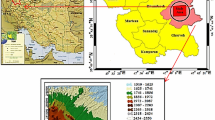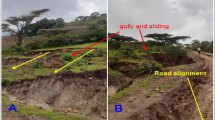Abstract
This present study primarily focuses on the susceptibility analysis of the settlement area and metalled road based on the susceptibility index maps/susceptibility zonation maps. Susceptibility index maps were prepared using thee recognized techniques, i.e., frequency ratio (FR), analytical hierarchy process (AHP), and logistic regression (LR) models. Elevation, slope angle, slope aspect, slope curvature, stream power index (SPI), topographic wetted index/compound topographic index (TWI/CTI), land use/land cover (LULC), normalized differential vegetation index (NDVI), lineament number density, distance from lineament (D2L), drainage density (DD), distance to drainage (D2D), geology, soil, and rainfall were incorporated for the preparation landslide susceptibility zonation maps. The prediction accuracy of three aforesaid models was 93.6, 89.3, and 94.7%, respectively. The result indicated that the total settlement area and metalled road lengths were 48.84 km2 and 314.38 km, respectively, within basin boundary. Settlement areas of 33.11, 35.28, and 60.39% were located on the very high susceptibility zones based on the FR, AHP, and LR models, respectively. Similarly, 57.61, 17.25, and 3.08% metalled road out of total road length were found on the very high susceptibility zones based on the aforesaid three models, respectively. Total 130 mouzas fall within the basin boundary; out of these, the most vulnerable mouza was Bara Adalpur Dwitiya Khanda under Matigara block because 100% of the settlement area falls in the category of very high susceptibility zones on the basis of FR model. Dhajea Tea Garden and Manjua Forest mouza under Jorebunglow Sukiapokhri and Mirik block, respectively, were most susceptible to landslide hazard in respect of road based on the AHP model. The findings of the research can be utilized to prioritize risk management so that the losses and damages of properties and lives can be minimized due to future landslide event.












Similar content being viewed by others
References
Akgun A, Turk N (2010) Landslide susceptibility mapping for Ayvalik (western Turkey) and its vicinity by multicriteria decision analysis. Environmental Earth Sciences 61:595–611
Atkinson PM, Massari R (1998) Generalized linear modeling of susceptibility to land sliding in the central Apennines, Italy. Comput Geosci 24:373–385
Ayalew L, Yamagishi H, Marui H, Kanno T (2005) Landslides in Sado Island of Japan: part II. GIS-based susceptibility mapping with comparisons of results from two methods and verifications. Eng Geol 81:432–445
Bhandari RK (2007) The Indian landslide scenario: strategic issues and action points. Disaster & Development 1:155–168
Bhattacharya SK (1998) The assessment of forest depletion and its conservation measures of the Rakti basin in Darjeeling. In: De AK et al (eds) Sustainable development and environment. Cosmo publications, New Delhi, pp 257–273
Bhattacharya SK (1999) A constructive approach to landslides through susceptibility zoning and case study in the Rakti basin of eastern Himalaya. Transactions, Japanese Geomorphological Union 20(3):317–333
Bhattacharya SK (2002) Tindharia cricket Colony landslide in Darjeeling Hills - a comparative account, 1996 and 2000. In: Basu S (ed) Changing environmental scenario of the Indian subcontinent. ACB publication, Calcutta, pp 400–405
Bhattacharya SK (2010) The study of some Aila induced landslides in the Darjeeling Hills, West Bengal, India. In: Sarkar S (ed) Geo-hazards in sub-Himalayan north Bengal, SAP-DRS I (monograph 1). Registrar, University of North Bengal, Rajarammohunpur, pp 70–75
Carrara A, Cardinali M, Detti R, Guzzetti F, Pasqui V, Reichenbach P (1991) GIS techniques and statistical models in evaluating landslide hazard. Earth Surf Process Landf 16:427–452
Carrara A, Cardinali M, Guzzetti F, Reichenbach P (1995) Gis Technology in Mapping Landslide Hazard. In: GIS technology in mapping landslide hazard. Geographical information systems in assessing natural hazards. Kluwer Academic Publishers, Dordrecht, pp 135–175
Clerici A, Perego S, Tellini C, Vescovi P (2002) A procedure for landslide susceptibility zonation by the conditional analysis method. Geomorphology 48:349–364
Dai FC, Lee CF, Li J, Xu ZW (2001) Assessment of landslide susceptibility on the natural terrain of Lantau Island, Hong Kong. Environ Geol 40:381–391
Ercanoglu M (2005) Landslide susceptibility assessment of SE Bartin (west Black Sea region Turkey) by artificial neural networks. Nat Hazards Earth Syst Sci 5:979–992
Ermini L, Catani F, Casagli N (2005) Artificial neural networks applied to landslide susceptibility assessment. Geomorphology 66:327–343
Fell R, Corominas J, Bonnard C, Cascini L, Leroi E, Savage WZ (2008) Guidelines for landslide susceptibility, hazard and risk zoning for land use planning. Eng Geol 102:85–98
Gorsevski PV, Foltz RB, Gessler PE, Elliot WJ (2006a) Spatial prediction of landslide hazard using logistic regression and ROC analysis. Trans GIS 10:395–415
Gorsevski PV, Jankowski P, Gessler PE (2006b) An heuristic approach for mapping landslide hazard by integrating fuzzy logic with analytic hierarchy process. Control Cybern 35(1):121–146
Hays WW (1981) Facing geologic and hydrologic hazards. Earth-science considerations, professional paper, 1240-B. U.S. Geological Survey, Reston, Virginia
Kayastha P, Dhital MR, De Smedt F (2013) Application of the analytical hierarchy process (AHP) for landslide susceptibility mapping: a case study from the Tinau watershed, West Nepal. Comput Geosci 52:398–408
Lee S, Min K (2001) Statistical analysis of landslide susceptibility at Yongin, Korea. Environ Geol 40:1095–1113
Lee S, Pradhan B (2007) Landslide hazard mapping at Selangor Malaysia using frequency ratio and logistic regression models. Landslides 4:33–41
Lee S, Talib JA (2005) Probabilistic landslide susceptibility and factor effect analysis. Environ Geol 47:982–990
Luzi L, Pergalani F, Terlien MTJ (2000) Slope vulnerability to earthquakes at sub regional scale using probabilistic techniques and geographic information systems. Eng Geol 5:313–336
Mandal S, Maiti R (2014) Semi-quantitative approaches for landslide assessment and prediction. Part of the series Springer Natural Hazards
Mandal B, Mandal S (2016) Assessment of mountain slope instability in the Lish River basin of eastern Darjeeling Himalaya using frequency ratio model (FRM) model. Earth Syst Environ 2:121
Mandal B, Mandal S (2017) Landslide susceptibility mapping using modified information value model in the Lish river basin of Darjiling Himalaya. Spatial Information Research 25(2):205–218. https://doi.org/10.1007/s41324-017-0096-4
Mandal S, Mandal K (2018) Bivariate statistical index for landslide susceptibility mapping in the Rorachu river basin of eastern Sikkim Himalaya, India. Spatial Information Research 26:59–75
Mansouri Daneshvar MR (2014) Landslide susceptibility zonation using analytical hierarchy process and GIS for the Bojnurd region, northeast of Iran. Landslides 11:1079–1091
Menard S (2001) Applied logistic regression. Sage University paper on quantitative applications in the social sciences, 2nd edn. Thousands Oaks, California, p 106
Mondal S, Maiti R (2012) Landslide susceptibility analysis of shiv-Khola watershed, Darjiling: a remote sensing & GIS based analytical hierarchy process (AHP). Journal of the Indian Society of Remote Sensing 40:483–496
Nautiyal SP (1951) A geological report on the hill slope stability in and around Darjeeling, W.B. Unpublished Report of the Geological survey of India
Park S, Choi C, Kim B, Kim J (2013) Landslide susceptibility mapping using frequency ratio analytic hierarchy process logistic regression and artificial neural network methods at the Inje area Korea. Environmental Earth Sciences 68(5):1443–1464
Pradhan B (2010) Remote sensing and GIS-based landslide hazard analysis and cross validation using multivariate logistic regression model on three test areas in Malaysia. Adv Space Res 45:1244–1256
Pradhan B, Lee S (2009) Delineation of landslide hazard areas using frequency ratio logistic regression and artificial neural network model at Penang Island, Malaysia. Environmental Earth Science 60:1037–1054
Sarkar S, Kanungo DP (2010) Landslides in relation to terrain parameters - A Remote Sensing and GIS approach, Natural Hazard Management. GIS development.net, p 1–6
Sengupta CK (1995) Detailed study of geofactors in selected hazard prone stretches along the surface communication routes in parts of Darjeeling Himalaya.” Unpublished GSI Report, FS 1993–94 & 1994–95
Sinha BN (1974) Inspection of the alternative road alignment near Padamchen - Zuluk Sector, Project Swastik Project Swastik. Unpublished GSI Report, FS 1973–1974
van Westen C (1997) Statistical landslide hazard analysis. ILWIS 2.1 for windows application guide. ITC Publication, Enschede, pp 73–84
Wu CH, Chen SC (2009) Determining landslide susceptibility in Central Taiwan from rainfall and six site factors using the analytical hierarchy process method. Geomorphology 112:190–204
Yilmaz I (2009) Landslide susceptibility mapping using frequency ratio logistic regression artificial neural networks and their comparison: a case study from Kat landslides (Tokat-Turkey). Comput Geosci 35:1125–1138
Yilmaz I, Yildirim M (2006) Structural and geomorphological aspects of the Kat landslides (Tokat-Turkey), and susceptibility mapping by means of GIS. Environ Geol 50(4):461–472
Author information
Authors and Affiliations
Corresponding author
Ethics declarations
Conflict of interest
The authors declare that they have no conflict of interest.
Rights and permissions
About this article
Cite this article
Mondal, S., Mandal, S. Landslide susceptibility and risk: a micro level study from the Balason River basin in Darjeeling Himalaya. Arab J Geosci 11, 197 (2018). https://doi.org/10.1007/s12517-018-3538-y
Received:
Accepted:
Published:
DOI: https://doi.org/10.1007/s12517-018-3538-y




